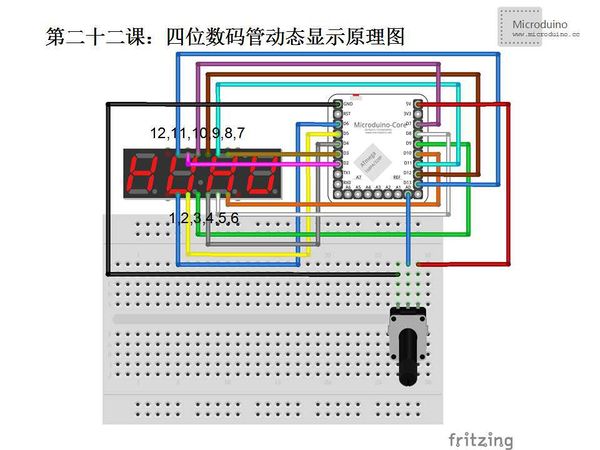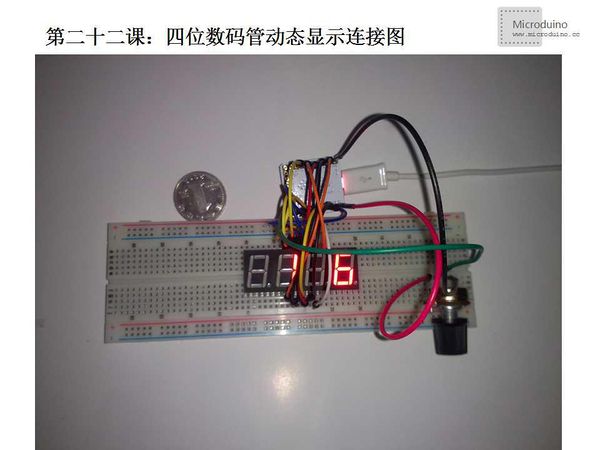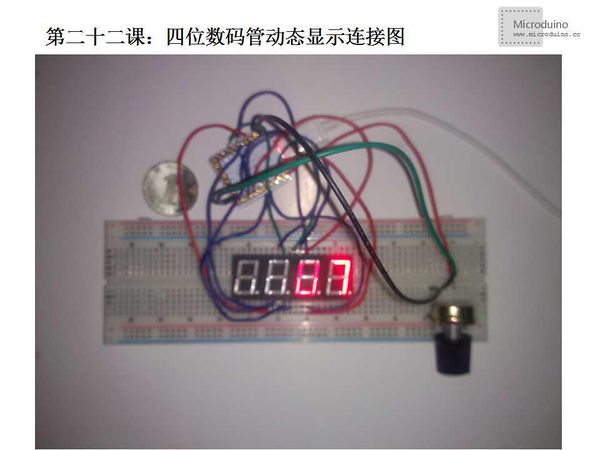Lesson 22--Microduino Four Digital Tube Dynamic Display
| Language | English |
|---|
ObjectiveThis tutorial will teach you dynamic display of the four digital tube base on last lesson's tutorial, using a potentiometer to control the displayed number. Equipment
SchematicPin Table
Program/* Four digital tube controllable display
** Note: In this experiment, use 5416AS chip, it is common cathode. If you are using common anode, need change the HIGH and LOG in some code.
*/
//Set anode interface
//D1 port use to do serial transmission (TX)
int a = 2;//D0,D1 port used for data tranmission, can't be used as digital pin.
int b = 3;
int c = 4;
int d = 5;
int e = 6;
int f = 7;
int g = 8;
int p = 9;//The decimal point
//Set cathode interface (Contro LED 1、2、3、4)
int d1 = 13;//Thousand
int d2 = 12;//Hundred
int d3 = 11;//Ten
int d4 = 10;//One
//Define variable
int del = 5000; //This variable uses to adjust clock
//int changepin = A0;//Input potentiometer data from A0 port
//int val=0;//Save the data from AO port
int val4=0; //The value on Thousand bit, that is the number on DIG1, corresponding pin is d1, Microduino's pin is 13
int val3=0; //The value on Hundred bit, that is the number on DIG2, corresponding pin is d2, Microduino's pin is 12
int val2=0; //The value on Ten bit, that is the number on DIG3, corresponding pin is d3, Microduino's pin is 11
int val1=0; //The value on One bit, that is the number on DIG4, corresponding pin is d4, Microduino's pin is 10
void setup()
{
Serial.begin(9600);//Set baud rate 9600
pinMode(d1, OUTPUT);
pinMode(d2, OUTPUT);
pinMode(d3, OUTPUT);
pinMode(d4, OUTPUT);
pinMode(a, OUTPUT);
pinMode(b, OUTPUT);
pinMode(c, OUTPUT);
pinMode(d, OUTPUT);
pinMode(e, OUTPUT);
pinMode(f, OUTPUT);
pinMode(g, OUTPUT);
pinMode(p, OUTPUT);
}
void loop()
{
val=analogRead(changepin);//Read the potentiometer value and assigned to val
Serial.println(val);//Output the val's value from serial
for(int i=0;i<25;i++)//In order to make the changing of digital don't be so sensitive, give a cycle 25 times to meet our requirement
{
//According to the val's digits to display respectively
if(val>=1000)//Four digits number
{
//Note, this uses two algorithm that get one digit from number. Just want to verify these two algorithm both work.
val4=(val/1000)%10; /*For example, 1023 divided by 1000 is equal to 1.023,
get the integer 1, that is the Thousand number. This is the first algorithem. Very simple.*/
val3=( val-((val/1000)%10*1000) )/100%10;
/*For example, 523 divided by 523 is equal to 5.23, integer number is 5, then multiplied by 100 got 500.
Using 523 minus 500 had 23, divided by 10 to get 2.3, got the integer 2, this is a hundred bit number.
This is the second algorithm, a little complicated, but also can be used*/
val2=(val-val/100%10*100)/10%10;
val1= val-val/10%10*10-val/1000%10*1000;
clearLEDs();
pickDigit(1);
pickNumber(val1);
delayMicroseconds(del);
clearLEDs();
pickDigit(2);
pickNumber(val2);
delayMicroseconds(del);
clearLEDs();
pickDigit(3);
pickNumber(val3);
delayMicroseconds(del);
clearLEDs();
pickDigit(4);
pickNumber(val4);
delayMicroseconds(del);
}
else if(val>=100 && val<1000)//Three digits number
{
val3=(val/100)%10;
val2=((val-(((val/100)%10)*100))/10)%10;
val1=val-((val/100)%10)*100-((((val-((val/100)%10)*100)/10)%10)*10);
clearLEDs();
pickDigit(1);
pickNumber(val1);
delayMicroseconds(2*del);
clearLEDs();
pickDigit(2);
pickNumber(val2);
delayMicroseconds(del);
clearLEDs();
pickDigit(3);
pickNumber(val3);
delayMicroseconds(del);
}
else if(val>=10 && val<100)//Two digits number
{
val2=(val/10)%10;
val1=val-(((val/10)%10)*10);
clearLEDs();
pickDigit(1);
pickNumber(val1);
delayMicroseconds(del);
clearLEDs();
pickDigit(2);
pickNumber(val2);
delayMicroseconds(del);
}
else if(val>=0 && val<10)//One digit number
{
val1=val;
clearLEDs();
pickDigit(1);
pickNumber(val1);
delayMicroseconds(del);
}
}
}
void pickDigit(int x) //Define function pickDigit(x) use to enable dx port
{
digitalWrite(d1, HIGH);
digitalWrite(d2, HIGH);
digitalWrite(d3, HIGH);
digitalWrite(d4, HIGH);
if(x==1)
{
digitalWrite(d4, LOW);
}
else if(x==2)
{
digitalWrite(d3, LOW);
}
else if(x==3)
{
digitalWrite(d2, LOW);
}
else if(x==4)
{
digitalWrite(d1, LOW);
}
}
void pickNumber(int x) //Define function pickNumber(x) use to display number x
{
switch(x)
{
default:
zero();
break;
case 1:
one();
break;
case 2:
two();
break;
case 3:
three();
break;
case 4:
four();
break;
case 5:
five();
break;
case 6:
six();
break;
case 7:
seven();
break;
case 8:
eight();
break;
case 9:
nine();
break;
}
}
void clearLEDs() //Clear screen
{
digitalWrite(a, LOW);
digitalWrite(b, LOW);
digitalWrite(c, LOW);
digitalWrite(d, LOW);
digitalWrite(e, LOW);
digitalWrite(f, LOW);
digitalWrite(g, LOW);
digitalWrite(p, LOW);
}
/*
The following code displays number 0 to 9 and decimal point dp, you can also use a two-dimensional array to finish it.
Please refer to blog:http://tahoroom.sinaapp.com/archives/5790.html
*/
void zero() //Define the pin value for number 0
{
digitalWrite(a, HIGH);
digitalWrite(b, HIGH);
digitalWrite(c, HIGH);
digitalWrite(d, HIGH);
digitalWrite(e, HIGH);
digitalWrite(f, HIGH);
digitalWrite(g, LOW);
}
void one() //Define the pin value for number 1
{
digitalWrite(a, LOW);
digitalWrite(b, HIGH);
digitalWrite(c, HIGH);
digitalWrite(d, LOW);
digitalWrite(e, LOW);
digitalWrite(f, LOW);
digitalWrite(g, LOW);
}
void two() //Define the pin value for number 2
{
digitalWrite(a, HIGH);
digitalWrite(b, HIGH);
digitalWrite(c, LOW);
digitalWrite(d, HIGH);
digitalWrite(e, HIGH);
digitalWrite(f, LOW);
digitalWrite(g, HIGH);
}
void three() //Define the pin value for number 3
{
digitalWrite(a, HIGH);
digitalWrite(b, HIGH);
digitalWrite(c, HIGH);
digitalWrite(d, HIGH);
digitalWrite(e, LOW);
digitalWrite(f, LOW);
digitalWrite(g, HIGH);
}
void four() //Define the pin value for number 4
{
digitalWrite(a, LOW);
digitalWrite(b, HIGH);
digitalWrite(c, HIGH);
digitalWrite(d, LOW);
digitalWrite(e, LOW);
digitalWrite(f, HIGH);
digitalWrite(g, HIGH);
}
void five() //Define the pin value for number 5
{
digitalWrite(a, HIGH);
digitalWrite(b, LOW);
digitalWrite(c, HIGH);
digitalWrite(d, HIGH);
digitalWrite(e, LOW);
digitalWrite(f, HIGH);
digitalWrite(g, HIGH);
}
void six() //Define the pin value for number 6
{
digitalWrite(a, HIGH);
digitalWrite(b, LOW);
digitalWrite(c, HIGH);
digitalWrite(d, HIGH);
digitalWrite(e, HIGH);
digitalWrite(f, HIGH);
digitalWrite(g, HIGH);
}
void seven() //Define the pin value for number 7
{
digitalWrite(a, HIGH);
digitalWrite(b, HIGH);
digitalWrite(c, HIGH);
digitalWrite(d, LOW);
digitalWrite(e, LOW);
digitalWrite(f, LOW);
digitalWrite(g, LOW);
}
void eight() //Define the pin value for number 8
{
digitalWrite(a, HIGH);
digitalWrite(b, HIGH);
digitalWrite(c, HIGH);
digitalWrite(d, HIGH);
digitalWrite(e, HIGH);
digitalWrite(f, HIGH);
digitalWrite(g, HIGH);
}
void nine() //Define the pin value for number 9
{
digitalWrite(a, HIGH);
digitalWrite(b, HIGH);
digitalWrite(c, HIGH);
digitalWrite(d, HIGH);
digitalWrite(e, LOW);
digitalWrite(f, HIGH);
digitalWrite(g, HIGH);
}
void dpoint() //Light the decimal point
{
digitalWrite(p, HIGH);
}
DebugStep 1:Copy the code it IDE and compile it Step 2:Set up circuit, as follows:: Step 3:Run program Step 5:Observe digital tube ResultDigital tube displays numbers between 0 and 1023, the potentiometer is used to control the size. Video |


